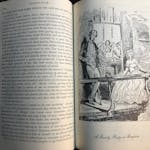It's a blink of an eye, in the grand scheme of things, since we shared our world with an awe-inspiring creature that roamed the Earth's frozen north.
The woolly mammoth stood more than 10 feet high and weighed more than 10,000 pounds. Covered in a thick mat of red hair, wearing a huge set of curved tusks, the mammoth was familiar to early humans, who drew its picture on cave walls. Mammoths were common 10,000 years ago and survived in scattered groups in the Arctic as recently as 4,000 years ago.
Well, don't blink now — because they may be back soon.
That's the premise of "Woolly," a true tale that reads like a detective thriller.
Based on interviews, first-person sources and published material, author Ben Mezrich has woven a fast-paced, compelling account of the real-life researchers who inhabit the literal frontiers of the planet and the symbolic frontiers of genetic science.
Their quest: Bring the woolly mammoth back to life by inserting genetic material from frozen, preserved carcasses into living Asian elephants, the mammoth's closest relative.
Sheep and mice have been cloned. A Korean billionaire has a laboratory where rich people pay $100,000 to have their beloved dead dogs reborn from the animals' own cells. These are actual facts.
But why re-create the woolly mammoth, of all things? In part, because scientists are always looking to do what's never been done before. And the mammoth is a good candidate for genetic experimentation because the carcasses are relatively fresh and may contain usable cells.
The backers of the project, who include Whole Earth Catalog founder Stewart Brand and tech billionaire Peter Thiel, also argue that reintroducing herds of mammoths to the tundra could help slow the thawing of permafrost. (You'll have to read the book for the full explanation.)
Mezrich builds suspense by jumping back and forth from past to present, with chapters tracing the paths of the players in this story: the brilliant Harvard scientist, the Russian tundra cowboy, the kid from the wrong side of the tracks who crashes the elite research club.
Importantly, he displays a deft hand with science, translating the complexity of genetic biology into terms understandable to the average reader. There's no sense of deus ex machina about how a mammoth could be re-created; the reader understands, step by step, how it could be achieved at the most fundamental level.
At various times during the tale, I had to stop to google people and events — not to understand them better, but to reassure myself that this really is a book about actual people and the things they're doing.
It is, and they are.
The action moves at a rapid pace, making for a page-turning experience, though the re-created dialogue and internal monologues of the characters come across as stilted and wooden at times.
And there's a jarring note at the end, where Mezrich includes a chapter headed "Three years from now," speculating about an outcome scientists haven't achieved. Of course, there's no woolly mammoth — yet. If there were, it would push aside every other news story on the planet.
In a work based on fact, it feels like a contrived way to close the story. But the slightly flat ending doesn't detract from a book that's informative and entertaining.
It's that rare creature: a book about science that would qualify as a beach read.
John Reinan is a reporter for the Star Tribune.
Woolly
By: Ben Mezrich.
Publisher: Atria Books, 293 pages, $26.





